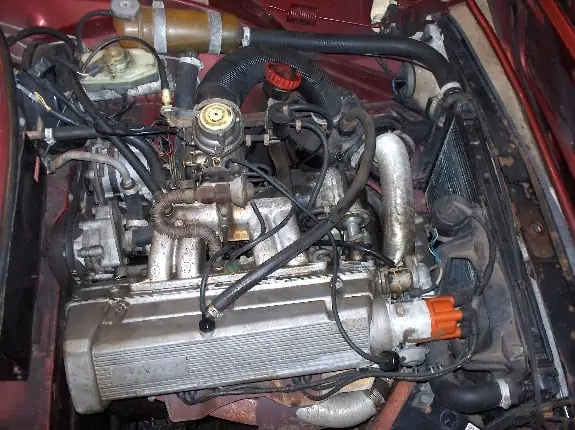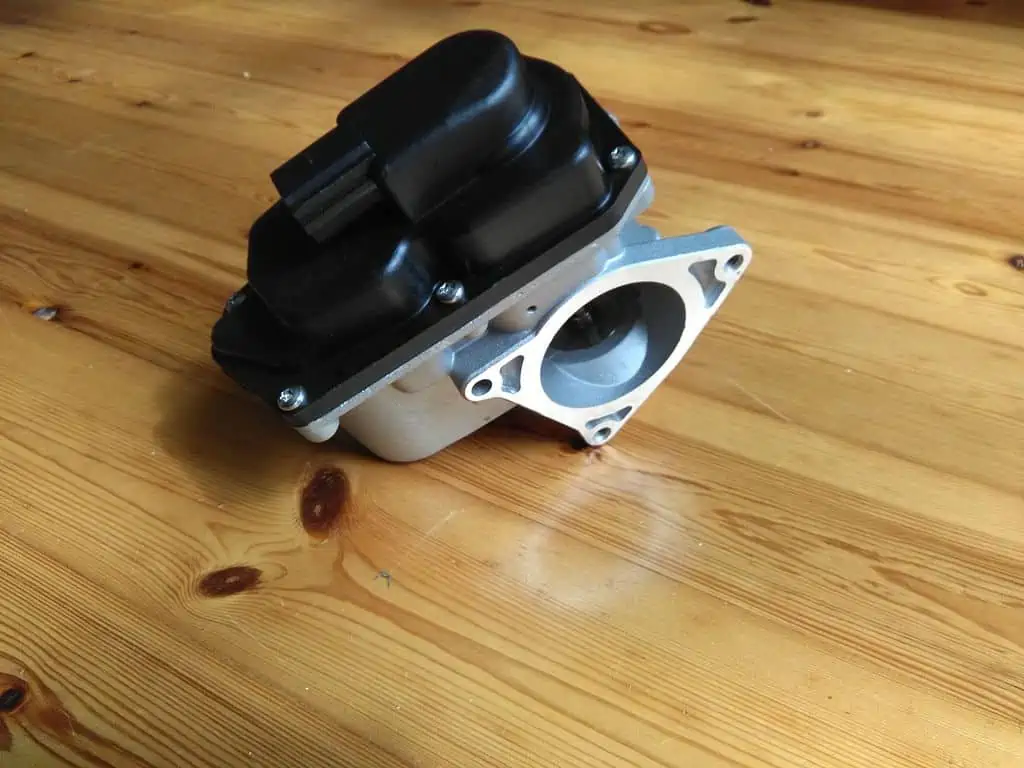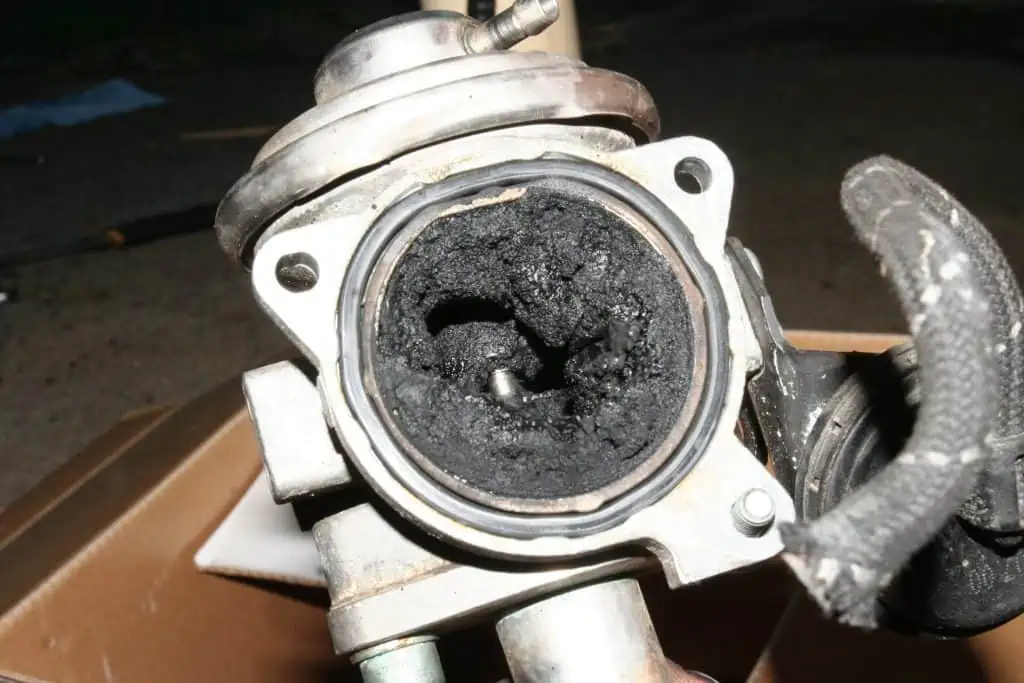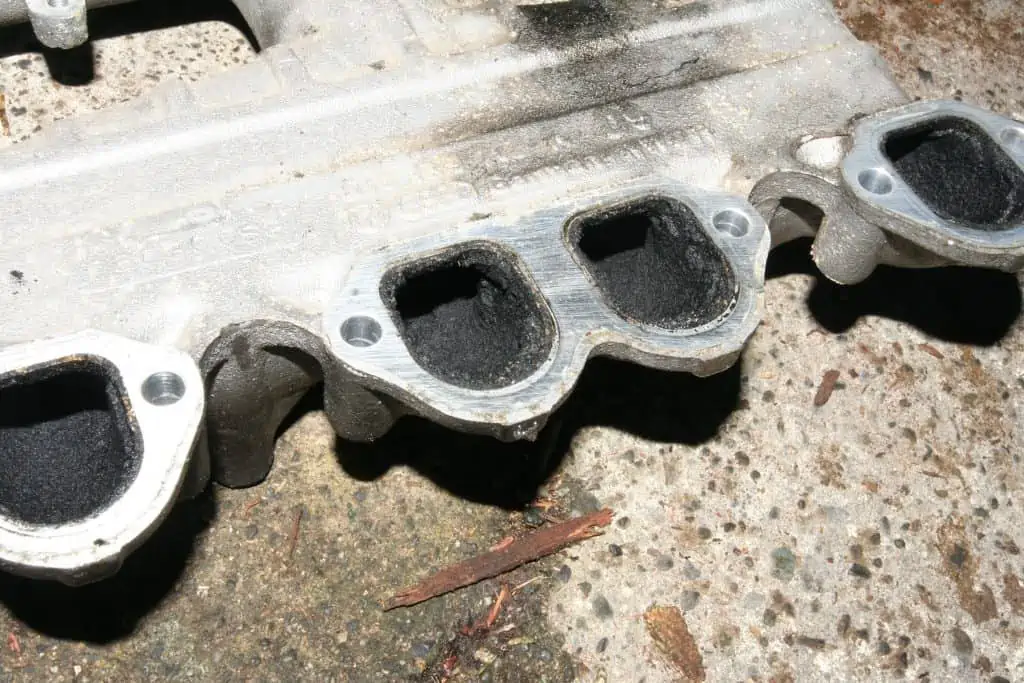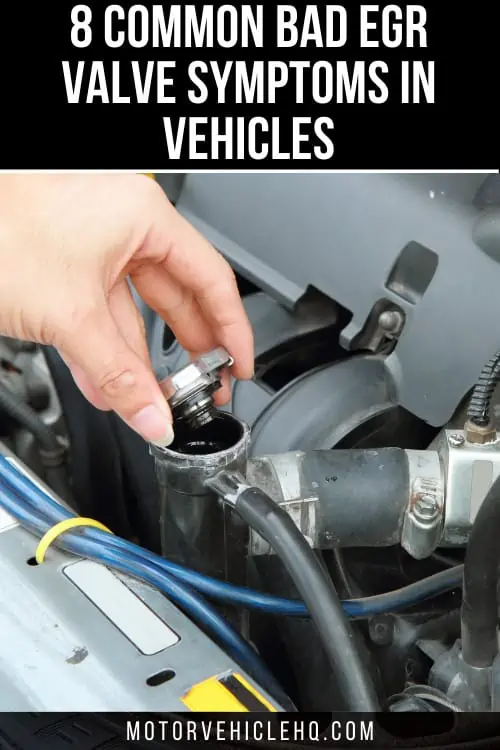Driving an eco-friendly car should be enjoyable for everyone. Having a fully working exhaust gas recirculation (EGR) valve in your car’s EGR system can help you achieve this.
It is risky for your car, your health, and the environment to be driving about town with bad EGR valve symptoms.
Keep reading this post to learn the bad EGR valve symptoms so you can recognize when this part of your car is breaking.
While you’re driving, the EGR valve controls the heat and chemicals of your car’s engine. It prolongs the engine’s lifespan while keeping it running smoothly. Your car’s defective EGR valve might cause you a lot of issues if you’re not aware of it.
The ability to cut pollutants discharged via the exhaust and lower engine cylinder temperature are two of the main advantages of having an EGR valve.
This article will examine the signs of a malfunctioning EGR valve. After reading this, you should be able to take care of any EGR valve problems on your own. It also explains how to test, fix, and replace a faulty EGR valve in your car.
An EGR Valve: What Is It?
The exhaust gas recirculation valve is another name for the EGR valve. This valve’s function is to enable the engine’s emissions to be recirculated by sending them back to the combustion chamber rather than letting them escape through the exhaust and out the tailpipe.
The EGR valve controls the flow of all of the vehicle’s exhaust gases. To do this, the EGR valve cooperates with the EGR system. Emissions are allowed to enter the EGR system, where they are regulated when the EGR valve opens.
Only in low- or medium-load cruising conditions are exhaust gases normally recirculated. Thus, the EGR valve won’t open at idle or full throttle, keeping the combustion chamber free of these exhaust gases.
The EGR valve might not be able to open and close correctly if it has a problem. The EGR system is designed to reduce emissions, not raise them, therefore this might have the opposite effect.
Until you experience some of the more glaring symptoms, you might not even be aware that this is happening.
What Is the Function of the EGR Valve?
The EGR valve returns a predetermined volume of exhaust to the combustion chamber. EGR Valve, which explains what it performs, stands for exhaust gas recirculation valve.
Performance as a whole benefit from the exhaust being circulated in several ways. The fuel-to-air ratio is first optimized without using more intake air.
Additionally, compared to fresh air, the exhaust has a distinct chemical composition. Because of the combustion chamber’s new chemical composition, which keeps it up to 150 degrees Celsius cooler, the engine runs more efficiently and generates cleaner emissions.
Because the EGR valve is sensor-powered, it understands when to open and close to maximize performance; however, if the sensors stop working or the EGR valve becomes jammed, you will experience issues.
Where is the EGR Valve Located?
The EGR valve on your car is usually found near the top of the engine, where it usually links to a pipe that goes to your exhaust. The EGR valve is generally extremely easy to find and gain access to if you know what to look for.
Saying that it is always simple to find would be a lie because, on certain models, it might be tucked away deep inside engine compartments.
In many automobile types, look for a metal tube that emerges from the top of the engine, then finds the valve that is connected to it. However, other automobile models lack these pipes because they are incorporated into the cylinder head.
What are the Bad EGR Valve Symptoms In Vehicles?
Several signs may indicate a malfunctioning part of your car’s engine system. So, if or when your vehicle exhibits the signs of a faulty EGR valve, you need to be very vigilant. These signs consist of:
Vehicle Rough Idling
A rough idle, often known as chugging or vibrating when idling, may begin to affect your car. You’ll have a difficult time driving as a result of this, and you could even slightly jar out of your seat.
You can have a misfire when gripping the wheel as your engine is idling. Your car will inevitably experience rough idling if your EGR valve is broken.
Additionally, this implies that little to no gas will be entering your combustion chamber, which has an impact on how well the engine of your car operates.
Your engine won’t idle correctly if your EGR valve doesn’t open or close, which suggests that insufficient gas is entering the vehicle’s internal combustion chamber. This is the cause of your car’s jerky idling.
Sluggish Acceleration
The exhaust gas from your car will flow into the intake manifold before the engine needs it if the engine valve is blocked, making it impossible for it to close or open.
When driving, this leads to poor acceleration. Without the proper ambient oxygen ratios, the extra air will result in a lean mixture in your combustion chamber, which will reduce the power of the combustion stroke.
Your Car Gets Overheated
An unreliable EGR valve may be to blame for the overheating in your car’s engine. Nitrogen oxides will still be released into the environment if the EGR valve is blocked, which might cause your engine’s temperature to rise to hazardous levels.
Additionally, it will leave unburned fuel in your exhaust, which might make your car smell strongly of gasoline and lower the efficiency of your fuel or diesel. When the temperature reaches a certain level, your engine will begin to bang.
Reduced Engine Performance
The performance of your vehicle’s engine is one of the first signs that the EGR valve in your EGR system is malfunctioning.
Electronically actuated EGR Valve for VW BMN engine by Towel401 / CC BY-SA 4.0
You will begin to notice problems like a loss of engine power and a decline in the gas pedal’s efficiency.
An imbalanced air-fuel ratio, which can lead to decreased fuel efficiency, is another indicator you could see. You’ll be forced to spend more money buying a lot of petrol or gasoline for your car as a result.
Additionally, your car will start to stall, becoming quite slow and loud. All of this will result in your car using more petrol or diesel than usual, leaving you to worry about the fuel economy. A defective spark plug, which is brought on by carbon buildup, may potentially be the cause of this.
Intensive Fuel Use
Your car’s engine will most likely start using quite a lot more gasoline than usual if the EGR valve is broken. For instance, your car typically gets 25 miles per gallon, or 10 liters every 90 kilometers, of fuel.
A defective EGR valve will result in a higher mile per gallon, which will need you to budget more money for gasoline.
An EGR valve is also intended to improve your car’s fuel economy. As a result, if the valve is broken, that functionality will no longer be available, forcing you to use more gasoline.
The EGR valve maintains the usual temperature of the combustion chamber while returning exhaust gas to the engine of your car.
Therefore, if this valve ceases working, the combustion chamber may get very hotter than usual, resulting in the discharge of nitrogen gases into the atmosphere.
The Check Engine Light Comes On
While driving, you should constantly check your engine signs in case an issue arises. When the EGR valve is broken, the engine check light will come on.
This light won’t come on unless the computer in your car detects a negative signal coming from the EGR valve or another engine part. When you see the engine check light on in your automobile, inspect the engine thoroughly and as soon as you can.
If the EGR valve does not execute one of these functions, it is intended to close and open. When there is a problem with your engine, your car’s computer will detect it and turn on the dashboard’s engine check light.
Fumes of Powerful Gas are Emitted
Your engine will consume more fuel or diesel than usual as a result of a faulty EGR valve. There is a very good risk that fuel will leak out of the exhaust system of your car through the tailpipe.
Fuel fumes may be released from your car’s exhaust as a result of this problem. No matter where the cabin of your car is, you will notice a strong gas odor that is uncomfortable and unhealthy. You should check your EGR valve if you consistently notice this odor.
Test for Emissions Fails
In the US, auto owners are required to test their vehicles’ emissions. This guarantees that their vehicle’s emissions of gas pose no danger to the environment or human life.
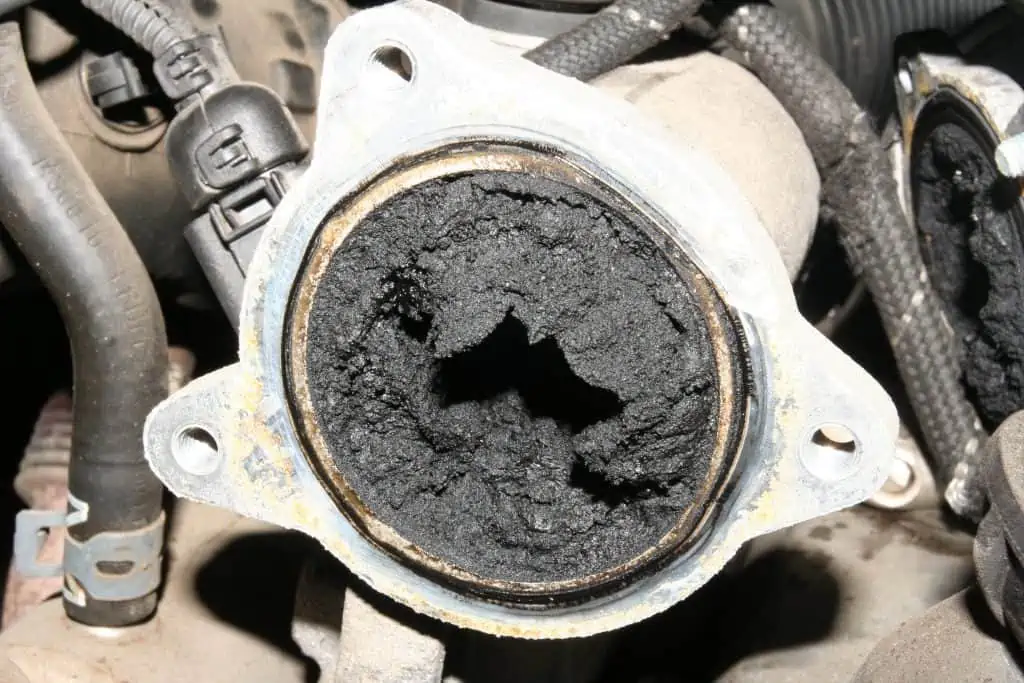
Depending on the state you reside in, you may need to take this exam every six months. Many drivers will be reminded by this test to pay more attention to how well their vehicle’s EGR valve is functioning.
Why Do EGR Valves Malfunction?
The EGR system may not operate correctly if there is a problem with it. The inside surface of your vehicle’s EGR valve may have accumulated carbon deposits, it may have pitting or a burned valve, it may have a broken diaphragm for a vacuum-type EGR valve, or it may have a distorted valve seat. The following factors may also contribute to this issue:
- Poorly managed engine
- Driving often over short distances and from the creation of an oil-water emulsion (particularly during the winter seasons).
- Intake of greasy air brought on by deteriorated valve stem seals, improper ventilation in your car, severe engine wear, or oil overfill.
- A malfunctioning engine cooling system is another potential cause of faults that might fail your EGR valve.
What are the Three Common Faults with the EGR Valve?
There are only three basic varieties of defective EGR valves, and each one exhibits a unique set of symptoms. There are two ways the EGR valve might go bad. Either it can always be closed or it can always be open.
The accumulation of unburned carbon deposits can also lead it to occasionally become blocked when it is in an inactive state. So let’s examine these challenging examples and see how to make a diagnosis.
An EGR Valve That Is Stuck Open
There is a risk for a vacuum leak to develop while the EGR valve is in the open position. This leak will lead to incomplete combustion, which is often what causes rough idling and rpm needle volatility.
Diagnosing an EGR Valve That Is Stuck In the Open Position
You need to locate a plunger shaft and manually inspect the valve’s position when the car is stationary and in the idle position. If that isn’t an option, several OBDs, or on-board diagnostics devices, may be inserted into the car and tested for problems. We’ll talk more about these devices later.
When the valve is jammed open, error codes like P1406 and P1404[2] may appear. The plug would then need to be taken out, and the empty spots would need to be filled with carbon cleaner.
In some other situations, all you need to do is utilize a valve cleaning kit before moving on to remove the suction from the valve if the working fluid inside the EGR leaks when the world is turned upside down or while it is held open.
An EGR Valve That Is Stuck Closed
As we previously discussed, if the EGR is closed and locked, significant NOx emissions are imminent. Even knocks might be produced by this sort of vehicle[3]. This will presumably cause a different form of timing disturbance and, of course, lead to excessive wear and tear. We most certainly do not want this.
EGR Valve by Moosealope / CC BY 2.0
Diagnosing An EGR Valve That Is Stuck In the Closed Position
You must always inspect the EGR valve that moves whenever the automobile revs up while parked. The faults P041 and P1406 on the OBD ECU scan tool may appear when the EGR is jammed closed.
You could hear a banging noise, which might mean that the valve has already been closed. The valve must be physically removed. At this point, a valve kit will be useful, or if you don’t want to get your hands filthy, you can always see your technician.
An EGR Valve That Is Clogged
The EGR valves may not always remain in their proper position due to unburned carbon deposits. Rough idle may result from this type of problem. Only in extreme circumstances while the car is in the start position is this possible. Exhaust gas cannot recirculate if EGR valves get clogged, which often occurs after passing 30 mph (45kmph).
Diagnosing and Repairing an EGR Valve That Is Clogged
On the ECU scan tool, errors P1404 and P1406 appear, indicating that the EGR valve is blocked. All you need to do to clear the junk is remove the valve and clean it using a valve cleaning kit or throttle body cleaner.
How Can You Test for Bad EGR Valve Symptoms?
If you can test your vehicle’s EGR valve correctly, you’ll save time and money. The exhaust gas recirculation (EGR) system of your automobile may lead to vacuum hose leaks, mechanical part issues, or carbon particles building up on the interior surface of the valve passages after extended engine operation.
One of the auto-mobile DIY skills you should learn is how to test your EGR valve. Make sure you perform this procedure in the daylight or, if it’s late, use an under-hood work light.
You may test both the modern computer-operated EGR valve and the outdated vacuum-type EGR valve by following these instructions. It’s simple to accomplish this:
The EGR valve may be tested using one of two methods. EGR valves with a vacuum system come first. Keep in mind that the valve is damaged if the diaphragm begins to leak. You’ll need to swap it out.
Investing in a vacuum tester is the most effective approach to testing this valve. You may use it to bleed your brakes, as well as carry out several other vehicle maintenance tasks, in addition to using it to test the valve.
All you have to do to use the vacuum tester is apply suction to your EGR valve and check to see whether the needle stays put.
If the needle stays put, your valve is most likely in great working order, but if it doesn’t, the valve’s internal diaphragm is damaged and has to be replaced. Allow the needle to remain for a while to check for pressure drop if it holds.
There is an alternative method you may use if you decide you don’t want to spend money on a vacuum tester. Finding your EGR valve should be your first step.
To assist you with this, you can check through the owner’s manual for your car. Then start the motor of your car and accelerate to roughly 2000 rpm. Access your valve carefully, then put your hand on it.
Intake manifold by Moosealope / CC BY 2.0
You will see an internal component moving up and down if your valve is operating properly. To make sure you are feeling the movement, you can rev your engine a few times.
If you don’t see this movement, your EGR valve may malfunction. All that is required to test a vacuum-type EGR valve at this point.
You must have a multimeter to do an “ohms test,” which measures resistance, on an electronic EGR valve. Once connected, a measurement of between 20 and 24 ohms should be shown. For further information, consult your vehicle’s maintenance manual.
The harness connector may now be gently retracted. On the valve, there are around six connections. To test the various valve terminals, use the multimeter’s negative and positive probes.
Check to see if the reading falls within the range of the valve’s anticipated reading when you test these terminals. If the answer is affirmative, your valve is working correctly.
How Can You Fix Bad EGR Valve Symptoms?
Your EGR valve may get clogged and unable to function effectively if there are numerous carbon buildups on the interior surface of the valve. This might cause a lot of issues. There are two major ways to fix a faulty EGR valve: cleaning the valve or replacing it.
But to make this procedure go more smoothly, you will require a set of mechanical tools. Put on the safety gear after that. particularly your hand gloves and goggles.
Please do not minimize the importance of wearing protective clothing when doing any mechanical process. Wear these before working on any auto repairs, please.
Here is a step-by-step guide to fixing bad EGR valve symptoms.
Step 1: Disconnect Any Electrical Connections
Remove any hoses or electrical connections that are connected to the EGR valve first. The mounting nuts supporting the valve must also be removed with caution.
Step 2: Examine the Valve Ports for Buildup and Blockage
Cross-check the engine’s near connections as well. They frequently become carbon-clogged, which is almost as terrible as the valve itself. So use a plier to wipe off substantial carbon deposits. To get rid of any leftover residue, use the EGR system cleanser and a little brush.
Step 3: Look for Debris in the EGR Valve
Use a high-quality EGR System cleaner and a tiny brush to thoroughly clean your EGR valve if it is blocked. Please be sure that not a single drop of this solution contacts any of the engine’s electrical components. To learn how to clean an EGR valve, check our prior post.
Step 4: Look for Heat-Related Damage
Check the EGR valve for heat, aging, and carbon buildup damage. If it is broken, get a replacement, but make sure it is the sort of valve that is advised for your car because not all cars have the same kind of EGR valve. Vacuum control is used with some valves, whereas electronic control is used with others.
Step 5: Clear the Gasket
Check the gasket for any carbon buildup as well. Use the system cleanser to clean it, if necessary. Before continuing, you can replace your gasket if you see that it is broken.
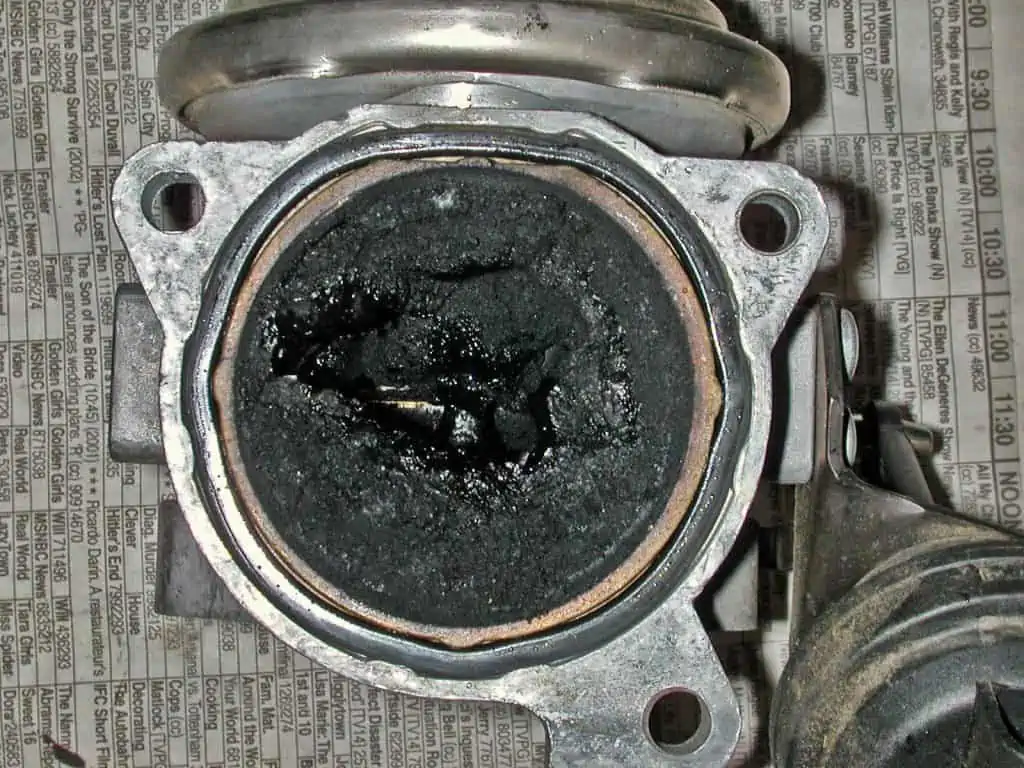
Step 6: EGR Valve Replacement
Reinstall the EGR valve, the EGR gasket, and any other loose parts once the parts have been cleaned and examined. Ensure that they are mounted to the engine per the manufacturer’s instructions. Do not overtighten the screws, please.
Step 7: Verify for Leaks
Utilizing the instructions from the manufacturer service, check the components’ functionality and make sure there are no vacuum or exhaust leaks. Go for a trip in your car and look out for any troubling signs.
What Kind of Codes Will Bad EGR Valve Symptoms Emit?
The exhaust gas recirculation (EGR) system in your automobile, which regulates an engine and lowers emissions, is associated with the P0401 fault code.
Imagine that a computer-controlled valve allows a specific amount of gases to be burned alongside the air-fuel combination in your engine. Your EGR system is activated in a situation like this under specific circumstances.
If the signal delivered by the circuit to the engine computer is abnormally low and outside of the manufacturer-recommended range, P0407 is assumed to be an OBD-II generic code for faults with your vehicle’s EGR system.
While a P0407 reading might indicate a malfunctioning engine computer or a grounding problem, a P0406 signal indicates faulty sensors, particularly if your EGR valve is acting up.
Exhaust gas recirculation (EGR) flow issue, P0400. If required, check the electrical connections, hose, or EGR valve.
P0401: Insufficient flow of recirculated exhaust gas. Look for blocked EGR ports or channels and the EGR valve.
Excessive exhaust gas recirculation is code P0402. Examine the system for a blocked open EGR valve, a component electrical short, or even a hose that has been improperly routed.
How is the Bad EGR Valve Replaced?
Your car’s EGR valve may be changed quite easily and quickly as well; in fact, the procedure is extremely identical to what was previously described.
Knowing when to replace your EGR valve is crucial to preventing future damages that may have resulted from an outdated valve. EGR valves can acquire problems over time.
Allowing your engine to run smoothly constantly will also be beneficial. You can follow these instructions to change your EGR valve:
If there are any electrical connections or hoses linked to the EGR valve, you must remove them since reaching the EGR valve may be challenging.
This will make it simple to reach the valve. Remove the screws that are keeping the engine’s EGR valve in place. Typically, depending on the type of vehicle, there are two to four. Scrape the surface to remove the sealing substance.
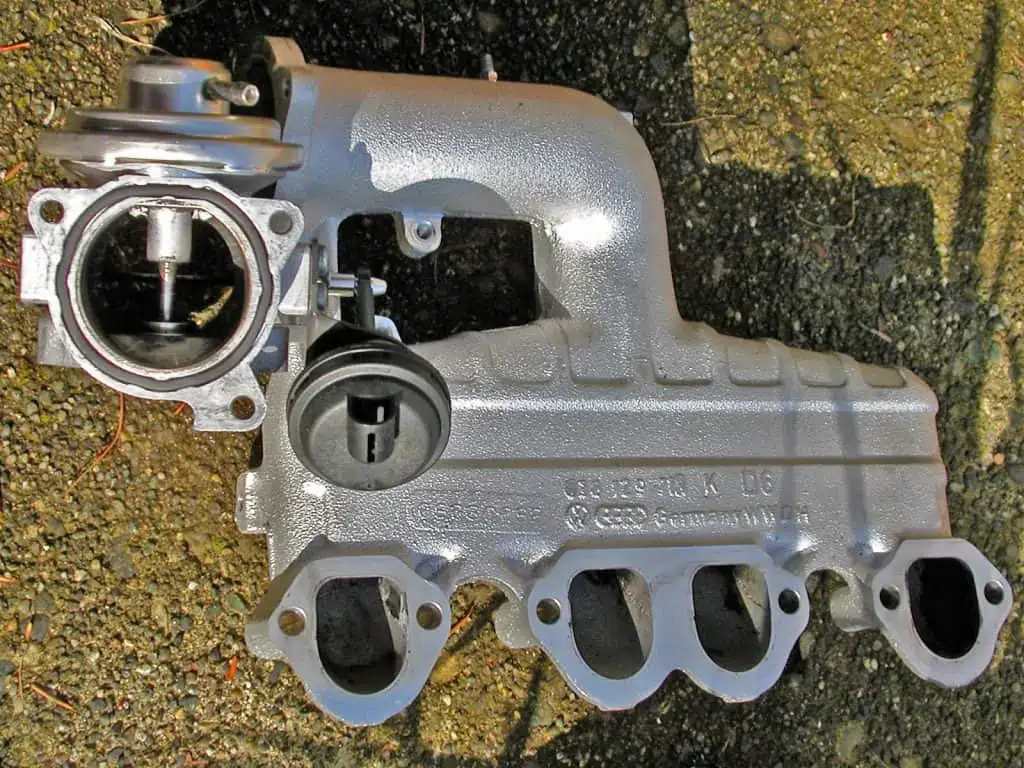
Get rid of your old EGR valve and install the new one, along with any necessary gaskets: The manufacturing requirements must be followed while doing this.
Reconnect any remaining electrical or hose connections. Analyze the system. Use the manufacturer service instructions to test the functionality and make sure there are no vacuum or exhaust leaks.
It’s that simple! To check for faults, you may use any of the diagnostic scan tools, or you can just test your work by driving your automobile.
Any of the signs of a faulty EGR valve that are stated above shouldn’t be present in you. If you do, let us know so we can appropriately assist you in this process.
How Much Is the Bad EGR Valve Replacement Cost?
Depending on the car you drive and the shop you take it to for repairs, the typical cost to replace an EGR valve ranges from $225 to $800. The EGR valve should cost between $150 and $400, and labor should cost between $75 and $400.
But check to see if you can clean the valve first before replacing it. Start by taking the EGR valve off, and cleaning it with a wire brush and carb cleaner. You just saved yourself a couple of hundred dollars if this works.
However, if you focus on the EGR valve and cleaning, it won’t solve your issue. Both good and terrible news is available. The good news is that it’s simple to replace with even a little technological know-how. The bad news is that for such a little element, the valve itself is a little more pricey.
While an aftermarket EGR valve for some cars may be found for about $50, the more common price range is between $150 and $400. In speaking, an OEM replacement component costs between $250 and $600, so expect to spend a bit extra if you want one.
Labor expenses for replacing the item with a mechanic often vary between $75 and $400. Therefore, even if you can save a little money by doing it yourself, you will still be responsible for most of the expenses.
What Happens If Bad EGR Valve Symptoms Are Ignored?
After reading the list of symptoms above, it should be clear why it would be a poor idea to overlook a malfunctioning EGR valve.
Reduced fuel efficiency, a rough idle, stalling, and an ongoing gasoline odor? These symptoms will eventually become unbearable, and you’ll need to find a cure.
If your car doesn’t pass a state inspection, you can’t lawfully drive it without paying a fee. If you are stopped while operating an unqualified vehicle, it will probably be impounded.
This implies that in addition to the initial fine, you will now be responsible for impound fees.
Should Your EGR Valve Stay Open or Closed?
Depending on how it operates, the EGR valve can either open or close. The two major positions of the EGR valve are open and closed. At any moment in operation, this position may change.
When your car’s engine starts, the EGR valve shuts. A little amount of power is required when idling at a low speed, and as a result, a small amount of oxygen is released.
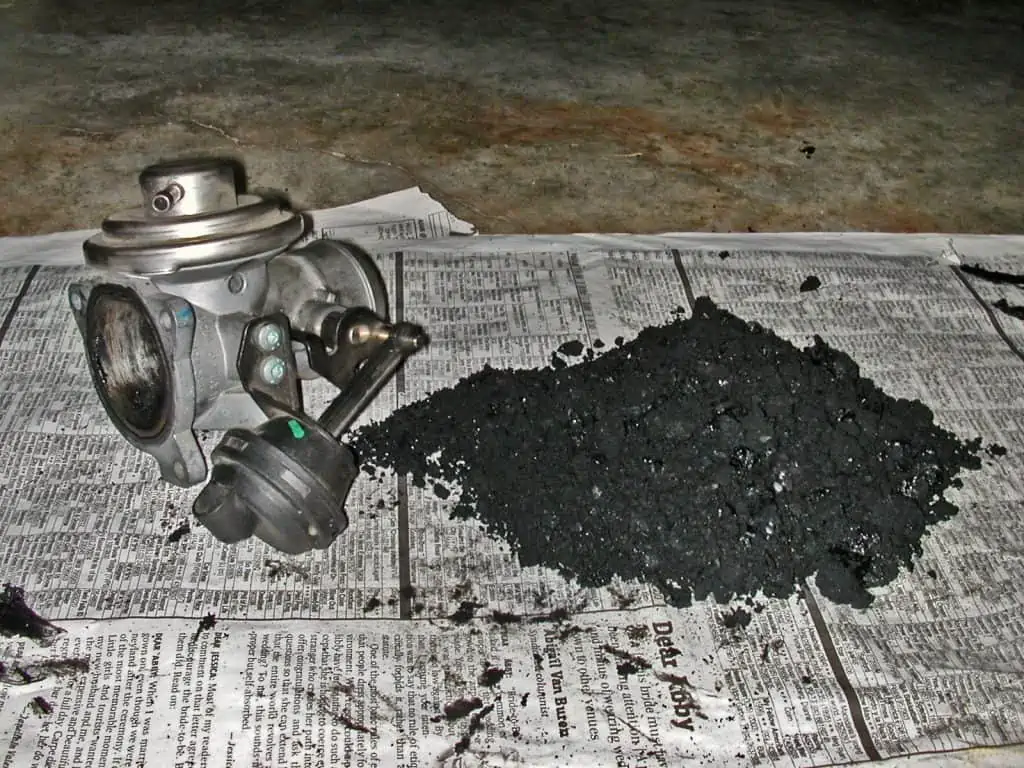
However, if the engine is idled at a high speed, it will need a lot of power, which will open the EGR valve to roughly 90%. For the engine of your car to perform smoothly, the EGR valve should be able to close and open as needed.
If the EGR is unable to do this, your EGR valve is blocked and requires cleaning. It could also indicate that your valve is broken.
What Occurs When the EGR Solenoid Malfunctions?
Another crucial engine part in your vehicle’s EGR system is the EGR solenoid. Engine performance concerns brought on by a malfunctioning EGR solenoid may be audible as an engine check, bangs, or pings.
Lowering the combustion temperature in the combustion chamber and minimizing nitrogen oxide emissions into the atmosphere are the two tasks of exhaust gas recirculation (EGR).
The exhaust gas recirculation solenoid (EGR solenoid), a relatively unnoticeable but crucial part of the car’s exhaust system, opens and shuts the link between the exhaust manifold and the intake manifold.
Your engine may stall if your EGR solenoid is broken, and other components may also be impacted.
Will a Bad EGR Valve Result in a Misfire?
A faulty EGR valve can undoubtedly result in a misfire. It is mostly brought on by blocked intake manifold channels in your car.
The flaw will have an impact on your car as well, such as a significant loss of power. Oil vapors cause the exhaust gas recirculation valve’s carbon buildup to grow, which frequently results in a jammed valve.
Assume that the EGR valve is constantly open and that a high proportion of exhaust gas causes the amount of air drawn to decrease. The control unit lowers both the engine power and the injection rate. Additionally, it can result in a misfire while you’re driving.
If the EGR valve in your car is broken, it might affect other parts as well. Additionally, you can see black smoke emanating from the exhaust. It can eventually cause pollution on the valves and in the intake manifold of your car.
Conclusion
Because the symptoms of a defective EGR valve are similar to those of other damaged engine components, they can occasionally be mistaken for other issues in the engine system.
Presumably, you can now recognize the different signs that an EGR valve is malfunctioning as well as how to solve this problem quickly. To prevent more unneeded problems, though, be sure of the cause before modifying or deleting any engine system component.
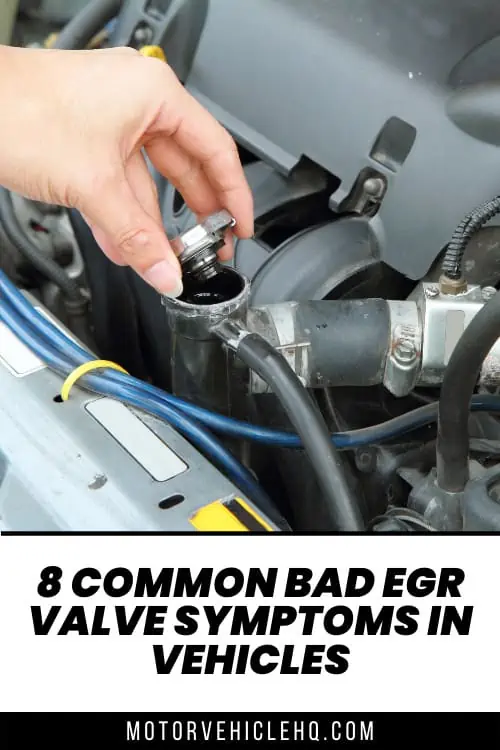

Nyangano Maurice specializes in vehicle troubleshooting and has more than 10 years of experience in the automobile industry. Over many years of experience as a car mechanic, he has acquired a broad range of skills, including engine repair, brake systems, electrical systems, and more. He frequently hosts community workshops and training programs to help motor vehicle owners understand their vehicles better.
